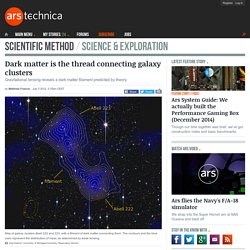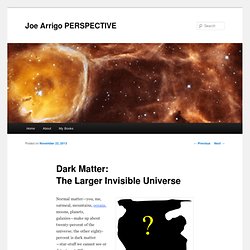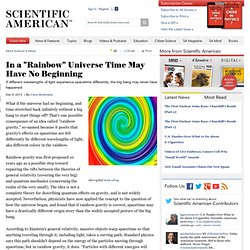

Attempts at simple explanations. Documentary The Universe Quantum Physics Microscopic Universe. Quantum World. Astronomy. The Elegant Universe Part 1 - Einstein's Dream - PBS NOVA. Quantum Mechanics and Reality, by Thomas J McFarlane. © Thomas J.

McFarlane 1995www.integralscience.org Most traditional [spiritual] paths were developed in prescientific cultures. Consequently, many of their teachings are expressed in terms of cosmologies or world views which we no longer find relevant. . .The question then naturally arises: Is it possible to incorporate both science and mysticism into a single, coherent world view? . . .Up until the first quarter of the twentieth century science was wedded to a materialist philosophy which was inherently antagonistic to all forms of religious insight.
With the advent of quantum physics, however, this materialist philosophy has become scientifically untenable. One-Minute Physics: Are unknowns part of the universe? Sandrine Ceurstemont, editor, New Scientist TV What's part of the universe?

You may think of it as incorporating everything that exists - both on Earth and in space - but could it also include the unknown? In this One-Minute Physics episode, film-maker Henry Reich delves into the notion of the universe as described by physics, distinguishing between the whole universe and what's observable. He looks at the three components of the universe that we are sure of and whether mathematics could be included or not. Dark matter is the thread connecting galaxy clusters. Simulations of the Universe on the largest scales show an unexpected resemblance to nerve cells in the human brain, with galaxy clusters playing the role of the cell body and thinner filaments of matter linking them like axons.

Galaxy surveys (such as the Sloan Digital Sky Survey, or SDSS) show that galaxies do cluster like our simulations predict. But the filaments that should connect them have been harder to find. Most of the mass in the Universe is dark matter—material that neither emits nor absorbs light—and filaments are predicted to be mostly dark matter: no galaxies, little hot gas. Einstein's general theory of relativity, however, tells us mass affects the path of light, and a group of astronomers have identified a dark matter filament by measuring this effect. Jörg P. MinutePhysics Videos. The World as a Hologram. The Search For The History Of The Universe's Light Emission.
The light emitted from all objects in the Universe during its entire history - stars, galaxies, quasars etc. forms a diffuse sea of photons that permeates intergalactic space, referred to as "diffuse extragalactic background light" (EBL).

Scientists have long tried to measure this fossil record of the luminous activity in the Universe in their quest to decipher the history and evolution of the Cosmos, but its direct determination from the diffuse glow of the night sky is very difficult and uncertain. Very high energy (VHE) gamma-rays, some 100,000,000,000 times more energetic than normal light, offer an alternative way to probe this background light, and UK researchers from Durham University in collaboration with international partners used the High Energy Stereoscopic System (HESS) gamma-ray telescopes in the Khomas Highlands of Namibia to observe several quasars (the most luminous VHE gamma-ray sources known) with this goal in mind. Source: PPARC. What is a Higgs Boson? Dark Matter: The Larger Invisible Universe. Normal matter—you, me, oatmeal, mountains, oceans, moons, planets, galaxies—make up about twenty-percent of the universe; the other eighty-percent is dark matter—star-stuff we cannot see or detect…yet.

Why are scientists so certain this enigmatic matter exists? Because the evidence permeates the universe, first observed by Fritz Zwicky, when he measured the motions of galaxies and calculated that there wasn’t enough visible matter to affect galaxies to extent they were being pulled around.WWWFirst, there isn’t enough gravitational force within galaxies to bind and hold them in their current formation; then there is an invisible element that keeps them rotating faster than scientists would expect, clusters of galaxies bend and distort light more than they should, and supercomputer simulations exhibit that clouds of ordinary matter in the early universe did not have enough gravity to create the tight formations of galaxies we now see. Dark energy and dark matter. How world works. In a "Rainbow" Universe Time May Have No Beginning. What if the universe had no beginning, and time stretched back infinitely without a big bang to start things off?

That's one possible consequence of an idea called "rainbow gravity," so-named because it posits that gravity's effects on spacetime are felt differently by different wavelengths of light, aka different colors in the rainbow. Rainbow gravity was first proposed 10 years ago as a possible step toward repairing the rifts between the theories of general relativity (covering the very big) and quantum mechanics (concerning the realm of the very small).
The idea is not a complete theory for describing quantum effects on gravity, and is not widely accepted. Four things you might not know about dark matter. Not long after physicists on experiments at the Large Hadron Collider at CERN laboratory discovered the Higgs boson, CERN Director-General Rolf Heuer was asked, “What’s next?”

One of the top priorities he named: figuring out dark matter. Dark matter is five times more prevalent than ordinary matter. It seems to exist in clumps around the universe, forming a kind of scaffolding on which visible matter coalesces into galaxies. The nature of dark matter is unknown, but physicists have suggested that it, like visible matter, is made up of particles. The Theory of Everything. The above equation was written by Dr.

Michio Kaku, theoretical physicist, who graduated first in his physics class at Harvard, and, when he was in high school built a 2.3 million electron volt atom-smasher in his parents garage. It is an equation for String Field Theory—a theory that may unite The Theory of Relativity with Quantum Theory, into a unified theory called The Theory of Everything. Theoretical physicists are those scientists who work in that twilight zone cutting edge realm between reality and science fiction. Symphony of Science - the Quantum World!
Efimov state. Fluid Experiments Support Deterministic “Pilot-Wave” Quantum Theory. For nearly a century, “reality” has been a murky concept.

The laws of quantum physics seem to suggest that particles spend much of their time in a ghostly state, lacking even basic properties such as a definite location and instead existing everywhere and nowhere at once. Only when a particle is measured does it suddenly materialize, appearing to pick its position as if by a roll of the dice. This idea that nature is inherently probabilistic — that particles have no hard properties, only likelihoods, until they are observed — is directly implied by the standard equations of quantum mechanics.
But now a set of surprising experiments with fluids has revived old skepticism about that worldview. Quantum entanglement. Quantum entanglement is a physical phenomenon that occurs when pairs or groups of particles are generated or interact in ways such that the quantum state of each particle cannot be described independently – instead, a quantum state may be given for the system as a whole.

Such phenomena were the subject of a 1935 paper by Albert Einstein, Boris Podolsky and Nathan Rosen,[1] describing what came to be known as the EPR paradox, and several papers by Erwin Schrödinger shortly thereafter.[2][3] Einstein and others considered such behavior to be impossible, as it violated the local realist view of causality (Einstein referred to it as "spooky action at a distance"),[4] and argued that the accepted formulation of quantum mechanics must therefore be incomplete. History[edit] However, they did not coin the word entanglement, nor did they generalize the special properties of the state they considered.
Concept[edit] Bohr and beyond: a century of quantum physics › Opinion (ABC Science) In Depth › Analysis and Opinion. The mention of “spin” of a particle is one that... - Say It With Science. Atoms Reach Record Temperature, Colder than Absolute Zero. Absolute zero is often thought to be the coldest temperature possible. But now researchers show they can achieve even lower temperatures for a strange realm of "negative temperatures. " Oddly, another way to look at these negative temperatures is to consider them hotter than infinity, researchers added. This unusual advance could lead to new engines that could technically be more than 100 percent efficient, and shed light on mysteries such as dark energy, the mysterious substance that is apparently pulling our universe apart. Uncertainty reigns over Heisenberg's measurement analogy. A row has broken out among physicists over an analogy used by Werner Heisenberg in 1927 to make sense of his famous uncertainty principle.
The analogy was largely forgotten as quantum theory became more sophisticated but has enjoyed a revival over the past decade. While several recent experiments suggest that the analogy is flawed, a team of physicists in the UK, Finland and Germany is now arguing that these experiments are not faithful to Heisenberg's original formulation. Heisenberg's uncertainty principle states that we cannot measure certain pairs of variables for a quantum object – position and momentum, say – both with arbitrary accuracy. Quantum Physics Made Relatively Simple: A Mini Course from Nobel Prize-Winning Physicist Hans Bethe. Personal and Historical Perspectives of Hans Bethe. Planck constant. Plaque at the Humboldt University of Berlin: "Max Planck, discoverer of the elementary quantum of action h, taught in this building from 1889 to 1928. " In 1905 the value (E), the energy of a charged atomic oscillator, was theoretically associated with the energy of the electromagnetic wave itself, representing the minimum amount of energy required to form an electromagnetic field (a "quantum").
Further investigation of quanta revealed behaviour associated with an independent unit ("particle") as opposed to an electromagnetic wave and was eventually given the term photon. Free particle. The Higgs Boson Explained. Amplituhedron. Two Diamonds Linked by Strange Quantum Entanglement. Macroscopic quantum phenomena. Physics Community Afire With Rumors of Higgs Boson Discovery. Rectangular potential barrier. Solution of Schrödinger equation for a step potential. In quantum mechanics and scattering theory, the one-dimensional step potential is an idealized system used to model incident, reflected and transmitted matter waves. Higgs boson: Call to rename particle to acknowledge other scientists.
22 April 2013Last updated at 13:00 ET By Pallab Ghosh Science correspondent, BBC News "Fathers" of the Higgs, L-R: Francois Englert, Peter Higgs, Carl Hagen and Gerald Guralnik.